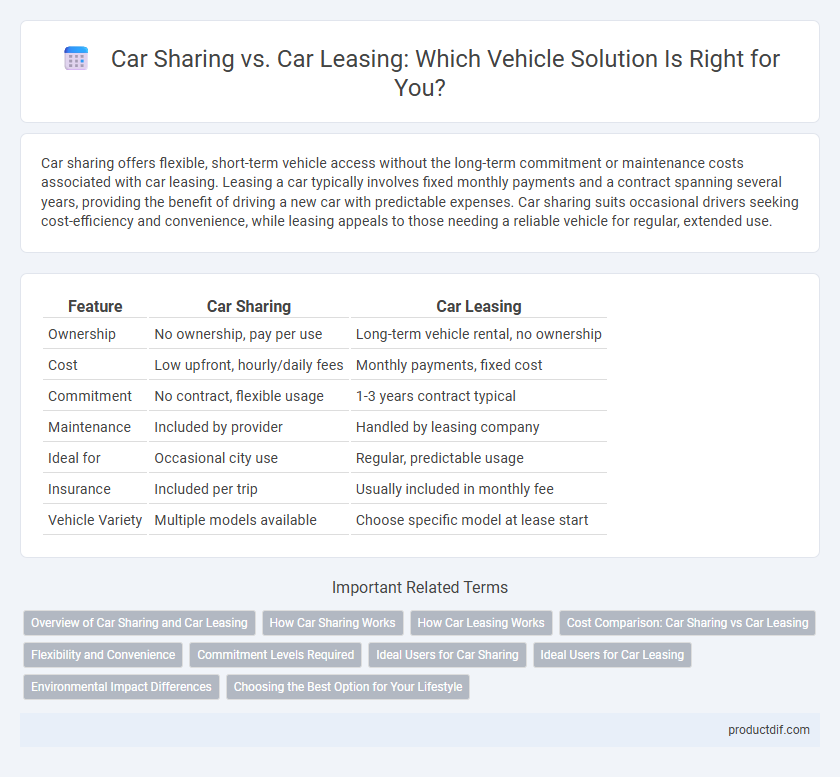Car sharing offers flexible, short-term vehicle access without the long-term commitment or maintenance costs associated with car leasing. Leasing a car typically involves fixed monthly payments and a contract spanning several years, providing the benefit of driving a new car with predictable expenses. Car sharing suits occasional drivers seeking cost-efficiency and convenience, while leasing appeals to those needing a reliable vehicle for regular, extended use.
Table of Comparison
| Feature | Car Sharing | Car Leasing |
|---|---|---|
| Ownership | No ownership, pay per use | Long-term vehicle rental, no ownership |
| Cost | Low upfront, hourly/daily fees | Monthly payments, fixed cost |
| Commitment | No contract, flexible usage | 1-3 years contract typical |
| Maintenance | Included by provider | Handled by leasing company |
| Ideal for | Occasional city use | Regular, predictable usage |
| Insurance | Included per trip | Usually included in monthly fee |
| Vehicle Variety | Multiple models available | Choose specific model at lease start |
Overview of Car Sharing and Car Leasing
Car sharing provides flexible, short-term vehicle access with costs based on usage duration and distance, ideal for occasional drivers seeking convenience without ownership responsibilities. Car leasing involves longer commitments, typically 2-4 years, where lessees pay monthly fees for exclusive use of a vehicle, often with mileage limits and maintenance included. Both models offer alternatives to traditional ownership, catering to different needs regarding flexibility, cost, and vehicle control.
How Car Sharing Works
Car sharing works by allowing users to access vehicles on-demand through a mobile app or membership platform, where they can book cars for short periods, often by the hour or minute. Vehicles are strategically located throughout a city, enabling convenient pick-up and drop-off without long-term commitments or ownership costs. This flexible model reduces the need for private car ownership while promoting sustainable urban mobility.
How Car Leasing Works
Car leasing involves a contractual agreement where the lessee pays a fixed monthly fee to use a vehicle over a predetermined period, typically two to four years, with mileage limits defined in the lease terms. At the end of the lease term, the car is returned to the leasing company, offering drivers lower upfront costs compared to buying a vehicle outright. Lease agreements often include maintenance packages and the option to purchase the car at a residual price once the lease expires.
Cost Comparison: Car Sharing vs Car Leasing
Car sharing typically incurs lower upfront costs and eliminates expenses such as maintenance, insurance, and depreciation, making it cost-effective for short-term or occasional use. Car leasing involves fixed monthly payments, often including maintenance and insurance, which may be more economical for long-term or frequent driving needs. Evaluating total cost of ownership, including fuel, mileage limits, and usage frequency, is essential for accurate comparison between car sharing and car leasing.
Flexibility and Convenience
Car sharing offers unparalleled flexibility by allowing users to access vehicles on-demand without long-term commitments, ideal for urban dwellers with variable transportation needs. Car leasing provides a convenient option for those seeking consistent access to a personal vehicle without ownership responsibilities, typically involving fixed monthly payments over a set contract period. Both models cater to different convenience preferences: car sharing emphasizes short-term, pay-as-you-go usage while leasing focuses on reliability and predictable costs.
Commitment Levels Required
Car sharing offers a flexible, low-commitment option ideal for occasional drivers, allowing users to pay only for the time and distance driven without long-term contracts. Car leasing requires a higher commitment with fixed monthly payments and lease terms usually spanning two to four years, suitable for individuals seeking regular access to a vehicle without ownership. The choice depends on lifestyle needs, usage frequency, and willingness to engage in extended agreements.
Ideal Users for Car Sharing
Car sharing is ideal for urban residents and occasional drivers who prioritize cost-efficiency and flexibility over long-term commitment. Users with unpredictable travel patterns benefit from access to vehicles on-demand without the financial burden of maintenance, insurance, or depreciation. This model suits environmentally conscious individuals seeking to reduce car ownership and lower their carbon footprint.
Ideal Users for Car Leasing
Car leasing is ideal for individuals who prefer lower monthly payments and want to drive new vehicles with the latest technology regularly without the commitment of ownership. It suits professionals with stable incomes who require reliable, well-maintained cars for extended periods, often benefiting from manufacturer warranties and maintenance packages. This option appeals to those seeking predictable expenses and the convenience of upgrading to newer models every few years.
Environmental Impact Differences
Car sharing significantly reduces environmental impact by lowering the total number of vehicles on the road, leading to decreased greenhouse gas emissions and reduced air pollution. In contrast, car leasing often involves longer vehicle usage periods but typically results in higher personal vehicle ownership rates, which contributes to increased resource consumption and carbon footprint. Studies show that car sharing can reduce carbon emissions per user by up to 40% compared to individual car leases.
Choosing the Best Option for Your Lifestyle
Car sharing offers flexibility and cost savings for urban dwellers with irregular transportation needs, while car leasing provides long-term access to a new vehicle with fixed monthly payments ideal for consistent commuters. Analyzing driving frequency, budget constraints, and vehicle preferences helps determine whether the pay-per-use model of car sharing or the commitment of leasing aligns better with personal lifestyle. Emphasizing convenience and financial impact, choosing between car sharing and leasing depends on balancing flexibility against long-term mobility requirements.
Car Sharing vs Car Leasing Infographic

 productdif.com
productdif.com